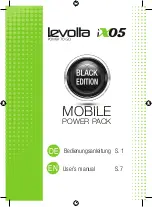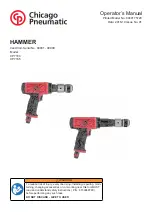
7
202 series Pneudraulic Installation Tools
(HK938)
GENERAL
The operating efficiency of your tool is directly related
to the performance of the entire system. Regular
inspection and the immediate correction of minor
problems will keep the tool operating efficiently,
and prevent downtime. A schedule of “preventive”
maintenance of the tool, nose assembly, hoses, trigger
and control cord, and POWERIG will ensure your tool’s
proper operation and extend its life.
NOTE
:
Huck tools should be serviced only by
personnel who are thoroughly familiar with its
operation.
- Service the tool in a clean, well-lighted area. Take
special care to prevent contamination of pneumatic
and hydraulic systems.
- Have available all necessary hand tools—standard
and special.
- Carefully handle all parts. Before reassembly,
examine them for damage
and wear. Always replace
seals when a tool is disassembled.
- Disassemble and assemble tool components in a
straight line. Do NOT bend, cock, twist, or apply
undue force.
- Have the appropriate
Service Parts Kit
(
202KIT
or
202VKIT
) available when servicing the tool; it includes
important consumable parts. Other components, as
experience dictates, should also be available. See
K
iTs
& A
ccessories
.
For supplementary information, see
T
roubleshooTing
,
and the
D
isAssembly
and
A
ssembly
procedures in this
manual.
DAILY
- If a Filter-Regulator-Lubricator unit is not being used,
uncouple the air disconnects and add a few drops of
hydraulic fluid or a light-weight oil to the air inlet of the
tool.
NOTE
:
If the tool is in continuous use, add a few
drops of oil in every 2–3 hours.
- Before connecting an air hose to the tool, bleed the
air lines to clear dirt or water.
- Check all hoses and couplings for damage and air
leaks; tighten or replace if necessary.
- Check the tool for damage and air or hydraulic leaks;
tighten, repair, or replace if necessary.
- Check the nose assembly for tightness and damage;
tighten or replace if necessary.
- Periodically, check the tool stroke. If the stroke is
short, add fluid. For more information, see
m
eAsuring
T
ool
s
TroKe
.
WEEKLY
- Disassemble, clean, and reassemble nose assembly
in accordance with applicable instructions
.
- Check the tool and all connecting parts for damage
and
fluid/air leaks; tighten or replace if necessary
.
Maintenance
Operating Instructions
BLIND FASTENER INSTALLATION
The fastener can be placed in either the work hole
or the end of the nose assembly. For both methods,
the tool and nose assembly must be held against the
work and at a right angle (90°) to it. Press and hold
the trigger until the fastener is installed and the pintail
breaks. Release the trigger.
MAGNA-GRIP
®
FASTENER INSTALLATION
Place the pin in the work-hole and place the collar over
the pin. See WARNINGS. (If the collar has only one
tapered end, that end
must
be out toward tool.) Hold
the pin in the hole. Push the nose assembly onto the
pin protruding from the collar until the anvil touches
the collar. Press and hold the trigger until the collar is
swaged and the pintail breaks. Release the trigger.
CAUTION: Remove excess gap from
between sheets so that enough of the pin-
tail protrudes from the collar that all of the
jaw teeth can grip the pintail grooves. Jaws
that are not fully gripping pintail grooves
will be stripped or broken.
WARNINGS:
Inspect tools for damage and wear before
using. Do not use if damaged or worn;
serious personal injury may occur.
Pulling a pin without a collar, or with collar
chamfer against workpiece, may result in
the pin becoming a high-speed projectile
when the pin grooves are stripped or the
pintail breaks off. Serious personal injury
may occur
to anyone in the pin’s “flight
path.” This includes pins that ricochet.
Broken pintails eject from the
deflector
with speed and force. To reduce the risk of
serious personal injury, be sure the pintail
deflector is directed away from all personnel.
Always use pintail bottles with models
202B and 202V. Replace damaged pintail
deflectors and bottles.






































